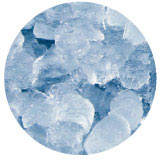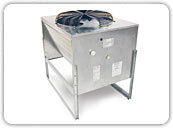Nugget Modular Heads
Ice nuggets are an increasingly popular option. Consumer prefered, this new and exciting ice is very cost effective. It uses less water and electricity than cubed ice, and it melts slower than flaked ice. Popular for use in dinks with fast food restaurants, such as Sonic.
 Shape- Hard, cylindrical, randomly sized bits of ice are actually flaked ice in compacted form. Not as crystal-clear as cube ice.
Shape- Hard, cylindrical, randomly sized bits of ice are actually flaked ice in compacted form. Not as crystal-clear as cube ice.
Advantages- Easy to chew. No wasteful foaming, perfect for cooling and maintaining the flavor of drinks. Ice doesn't stick together and stays free flowing. Displays look crisp and stay fresh longer. Requires less work to re-ice displays. Machines
are a bit more compact and are said to require less maintenance.
Uses for it- Carbonated dinks, Blended Cocktails, Produce, Seafood, or Meat Displays, Ice Dispensing, Salad Bars, and Hospitals.
![]()
Air-Cooled vs Water -Cooled Ice Makers
The choice of an air-cooled or water-cooled machine is an important one. The first thing to consider is the environment where your ice machine will be located. Temperature and air circulation, effects your ice machine's performance and efficiency.
Air-Cooled
An air-cooled ice maker is more affordable, and can be installed anywhere you have access to water and electricity. The down side is they use more energy, can exhaust significant amounts of heat, and are too noisy to be located close to customer service areas.
Air-cooled ice makers should not be used in a small room without air circulation. It needs to have 6” of clearance on all air intake and discharge areas. As a rule of thumb, a 10°F air temperature increase may reduce daily ice production by 10% when using an air-cooled machine. It is not recommend for small kitchens where the ice machine must be located near the cooking equipment and air temperatures are typically over 80F. The increased room temperature will melt ice in the bin quicker, requiring more ice-making capacity to replenish and fill the bin.
Water-Cooled
A water-cooled ice maker generates less heat, uses less electricity, and is quieter than air-cooled machines. Water-cooled units are more efficient than air-cooled units and great for environments where high water and ambient air temperatures would virtually shut down an air cooled machine.
The problem is that these machines are not allowed in certain areas because of the cost of the water. In most areas, water-cooled machines must be on a closedloop systems, meaning no water can be dumped down a drain. A closed loop and cooling tower may or may not be feasible in a smaller restaurant.
Generally, a water-cooled unit should only be chosen if one or more of the following conditions exists where the machine will be installed:
• Ambient air temperatures of more than 80°F
• Air contains a high level of contaminants such as grease
• A lack of air circulation
Remote-Cooled Ice Makers
Remote ice makers are quieter than typical machines because some of the machinery has been relocated. Remote air-cooled icemakers require the purchase of a separate remote condenser.
The condenser can be located up to about 50 feet away, including the roof. Installation costs can be higher than for self-contained machines, due to running refrigeration lines to a remote location.
 Remote Condensers
Remote Condensers
Designed for use with remote-cooled ice makers
Remote condensers allow quiet operation and provides energy savings.The remote unit takes the biggest heat-producing component, the condenser, out of the ice maker and your kitchen altogether. The remote approach does not require water and removes most of the heat from the service area.
The Bottom Line
Air-cooled ice makers use the most energy—5.4 to 22.5 kWh per 100 pounds of ice—but cost
less than water-cooled models and use less water.
Water-cooled ice makers are more efficient than air-cooled units, using 4.7 to 14.2 kWh per 100
pounds of ice. The heat removed in making the ice is discharged outside the building, so air-conditioning costs are not affected.
Remote air-cooled condensers transfer heat generated by the ice making process outside of
the building. Like water-cooled units, they reject heat outside of conditioned spaces and, therefore, do not increase air conditioning loads. They also reduce noise levels inside by up to 75 percent, but there are extra installation costs for running lines to a remote location.


